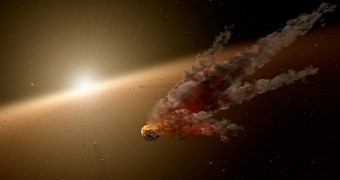It's almost impossible to tell just by looking at images that astronomers share with the public every now and then, but space is by no means a peaceful and quiet place.
These images might make us think that stars, planets and whatnot have nothing else to do except float about looking positively stunning, but this is not the case. On the contrary, there is quite a lot of commotion going on in space.
In fact, scientists with NASA say that data obtained with the help of the Spitzer Space Telescope indicates that, not too long ago, two asteroids smashed into another while hanging about in the proximity of a young star.
Truth be told, the Spitzer Space Telescope did not get to observe this collision from a front row seat. It did, however, spot a massive eruption of dust close to a 35-million-year-old star which goes by the name of NGC 2547-ID8.
A representation of this eruption of dust is available in the image next to this article. Mind you, the image is merely an artist's impression, but one can only assume that, if it was anything like the blast in this picture, the real one was nothing short of impressive.
Researchers say that, although they are yet to confirm this theory, they have reasons to believe that the dust eruption was the aftermath of a powerful collision between two very large asteroids. Such collisions have been shown to encourage planet formation.
“We think two big asteroids crashed into each other, creating a huge cloud of grains the size of very fine sand, which are now smashing themselves into smithereens and slowly leaking away from the star,” study lead author Huan Meng with the University of Arizona, Tucson, said in a statement.
“We not only witnessed what appears to be the wreckage of a huge smashup, but have been able to track how it is changing – the signal is fading as the cloud destroys itself by grinding its grains down so they escape from the star,” added study co-author Kate Su, also with the University of Arizona, Tucson.
The researchers say that they plan to continue studying this cloud of dust, and hope that this investigation will help them gain a better understanding of the processes that translate into the formation of rocky planets.
Thus, they expect that, in time, the dust, together with other particles in the proximity of this star, will coalesce and form planets. According to previous research, it takes about 100 million years for dusty material orbiting around young stars to clump together and birth planets.

 14 DAY TRIAL //
14 DAY TRIAL //